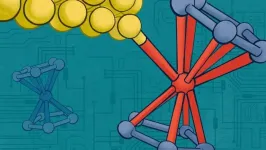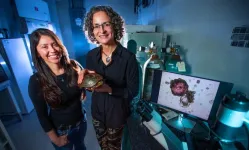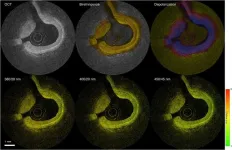(Press-News.org) In a new Nature Communications study, Columbia Engineering researchers report that they have built highly conductive, tunable single-molecule devices in which the molecule is attached to leads by using direct metal-metal contacts. Their novel approach uses light to control the electronic properties of the devices and opens the door to broader use of metal-metal contacts that could facilitate electron transport across the single-molecule device.
The challenge
As devices continue to shrink, their electronic components must also be miniaturized. Single-molecule devices, which use organic molecules as their conductive channels, have the potential to resolve the miniaturization and functionalization challenges faced by traditional semiconductors. Such devices offer the exciting possibility of being controlled externally by using light, but -- until now - researchers have not been able to demonstrate this.
“With this work, we've unlocked a new dimension in molecular electronics, where light can be used to control how a molecule binds within the gap between two metal electrodes,” said Latha Venkataraman, a pioneer in molecular electronics and Lawrence Gussman Professor of Applied Physics and professor of chemistry at Columbia Engineering. “It's like flipping a switch at the nanoscale, opening up all kinds of possibilities for designing smarter and more efficient electronic components.”
The approach
Venkataraman’s group has been studying the fundamental properties of single-molecule devices for almost two decades, exploring the interplay of physics, chemistry, and engineering at the nanometer scale. Her underlying focus is on building single-molecule circuits, a molecule attached to two electrodes, with varied functionality, where the circuit structure is defined with atomic precision.
Her group, as well as those creating functional devices with graphene, a carbon-based two-dimensional material, have known that making good electrical contacts between metal electrodes and carbon systems is a major challenge. One solution would be to use organo-metallic molecules and devise methods to interface electrical leads to the metal atoms within the molecule. Towards this goal, they decided to explore the use of organo-metallic iron-containing ferrocene molecules, which are also considered to be tiny building blocks in the world of nanotechnology. Just like LEGO pieces can be stacked together to create complex structures, ferrocene molecules can be used as building blocks to construct ultra-small electronic devices. The team used a molecule terminated by a ferrocene group comprising two carbon-based cyclopentadienyl rings that sandwich an iron atom. They then used light to leverage the electrochemical properties of the ferrocene-based molecules to form a direct bond between the ferrocene iron center and the gold (Au) electrode when the molecule was in an oxidized state (i.e. when the iron atom had lost one electron). In this state, they discovered that ferrocene could bind to the gold electrodes used to connect the molecule to the external circuitry. Technically, oxidizing the ferrocene enabled the binding of a Au0 to an Fe3+ center.
“By harnessing the light-induced oxidation, we found a way to manipulate these tiny building blocks at room temperature, opening doors to a future where light can be used to control the behavior of electronic devices at the molecular level,” said the study’s lead author Woojung Lee, who is a PhD student in Venkararaman’s lab.
Potential impact
Venkataraman’s new approach will enable her team to extend the types of molecular terminations (contact) chemistries they can use for creating single-molecule devices. This study also shows the ability to turn on and off this contact by using light to change the oxidation state of the ferrocene, demonstrating a light-switchable ferrocene-based single-molecule device. The light-controlled devices could pave the way for the development of sensors and switches that respond to specific light wavelengths, offering more versatile and efficient components for a wide range of technologies.
The team
This work was a collaborative effort involving synthesis, measurements, and calculations. The synthesis was done primarily at Columbia by Michael Inkpen, who was a post-doc in the Venkataraman group and is now an assistant professor at the University of Southern California. All the measurements were made by Woojung Lee, a graduate student in the Venkataraman group. The calculations were performed both by graduate students in the Venkataraman group and by collaborators from the University of Regensburg in Germany.
What’s next
The researchers are now exploring the practical applications of light-controlled single-molecule devices. This could include optimizing device performance, studying their behavior under different environmental conditions, and refining additional functionalities enabled by the metal-metal interface.
END
Using light to precisely control single-molecule devices
2024-03-05
ELSE PRESS RELEASES FROM THIS DATE:
Boston College researchers use electrocatalysis for site-specific protein modification
2024-03-05
Chestnut Hill, Mass. (03/05/2024) – Boston College researchers used a mild charge of electricity to precisely modify proteins, a new tool that can be used to develop novel biotherapeutics and protein-based research tools, the team reported recently in the journal Nature Chemistry.
The team, led by BC professors of chemistry Abhishek Chatterjee and Eranthie Weerapana, developed and optimized a novel electrochemical protein labeling reaction called "eCLIC", that enables precise modification of site-specifically incorporated 5-hydroxytryptophan (5HTP) residues on many different proteins including full-length therapeutic antibodies.
“We used this strategy to generate ...
Infotainment is coming for your news, warns Concordia Ph.D. student Robert Marinov
2024-03-05
There are plenty of reasons to worry about the quality of contemporary Canadian journalism, beyond shrinking newsrooms and attention spans.
Once considered a vital pillar of a healthy democracy, the country’s biggest newspapers have been embracing the type of content critics refer to as “infotainment,” which uses entertainment-style methods to communicate politically relevant information.
In a new paper published in the Canadian Journal of Political Science, PhD candidate Robert Marinov examines, measures and evaluates the scope and nature ...
Lab-grown liver organoid to speed up turtle research, making useful traits easier to harness
2024-03-05
AMES, Iowa – At a Biotechnology Council event a few years ago, Nicole Valenzuela’s ears perked up when she heard what a group of researchers in Iowa State University’s College of Veterinary Medicine had in the works: a method for creating a lab-grown, simplified mimic of dog intestines.
“I told them, ‘Oh! I want to do that but with turtles. Is it doable?” said Nicole Valenzuela, professor of ecology, evolution and organismal biology at Iowa State.
It is indeed doable, new research from a team led by Valenzuela shows. The three-dimensional clusters ...
Patients with Parkinson’s disease who experience freezing of gait have sleep disorders, study shows
2024-03-05
Parkinson’s disease patients who experience freezing of gait (a sudden inability to initiate or continue movement, often resulting in a fall) wake up several times during the night, feel sleepy during the day, and have REM sleep behavior disorder. Rapid eye movement (REM) sleep plays a role in the maintenance of many cognitive processes.
These are key findings of a study supported by FAPESP and conducted by researchers at São Paulo State University (UNESP) in Brazil and Grenoble Alps University (UGA) in France. An article on the study is published in ...
Study finds no safety concerns when the dapivirine vaginal ring is used during the second and third trimesters of pregnancy, according to results presented at CROI 2024
2024-03-05
PITTSBURGH, March 5, 2024 -- Results of the third and final cohort of the DELIVER (MTN-042) Phase IIIb study found no safety concerns with use of the monthly dapivirine vaginal ring beginning during the second trimester of pregnancy and up to the time of delivery, researchers reported today at the Conference on Retroviruses and Opportunistic Infections (CROI 2024) in Denver. With this latest data, the researchers believe there is now sufficient evidence that the dapivirine ring is safe to use ...
After decades of Arctic sea ice getting faster and more hazardous for transport, models suggest a dramatic reversal is coming, York University study finds
2024-03-05
TORONTO, March 5, 2024 – Will ice floating in the Arctic Ocean move faster or slower over the coming decades? The answer to this question will tell us whether marine transportation can be expected to get more or less hazardous. It might also have important implications for the rate of ice cover loss, which is hugely consequential for Northern Indigenous communities, ecosystems, and the global climate system.
While observational data suggest the trend has been towards faster sea ice speeds, ...
Pioneering work in computational and theoretical neuroscience is awarded the world’s largest brain research prize
2024-03-05
The Lundbeck Foundation has announced the recipients of The Brain Prize 2024, the world’s largest award for outstanding contributions to neuroscience. This year’s award recognizes the pioneering work of three leading neuroscientists – Professor Larry Abbott at Columbia University (USA), Professor Terrence Sejnowski at the Salk Institute (USA), and Professor Haim Sompolinsky at Harvard University (USA) and the Hebrew University (Israel).
Theoretical and computational neuroscience permeates neuroscience today ...
New cardiovascular imaging approach provides a better view of dangerous plaques
2024-03-05
WASHINGTON — Researchers have developed a new catheter-based device that combines two powerful optical techniques to image the dangerous plaques that can build up inside the arteries that supply blood to the heart. By providing new details about plaque, the device could help clinicians and researchers improve treatments for preventing heart attacks and strokes.
Atherosclerosis occurs when fats, cholesterol and other substances accumulate on the artery walls, which can cause these vessels to become thick ...
BU study finds robotic-assisted surgery for gallbladder cancer as effective as traditional surgery
2024-03-05
(Boston)—Each year, approximately 2,000 people die annually of gallbladder cancer (GBC) in the U.S., with only one in five cases diagnosed at an early stage. With GBC rated as the first biliary tract cancer and the 17th most deadly cancer worldwide, pressing attention for proper management of disease must be addressed. For patients diagnosed, surgery is the most promising curative treatment. While there has been increasing adoption of minimally invasive surgical techniques in gastrointestinal malignancies, including utilization of laparoscopic ...
We know the Arctic is warming -- What will changing river flows do to its environment?
2024-03-05
AMHERT, Mass.– Scientists at the University of Massachusetts Amherst recently combined satellite data, field observations and sophisticated numerical modeling to paint a picture of how 22.45 million square kilometers of the Arctic will change over the next 80 years. As expected, the overall region will be warmer and wetter, but the details—up to 25% more runoff, 30% more subsurface runoff and a progressively drier southern Arctic, provides one of the clearest views yet of how the landscape will respond to climate change. The results were published in the journal The Cryosphere.
The Arctic is defined ...






